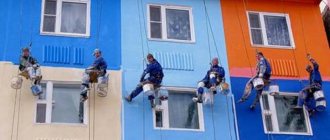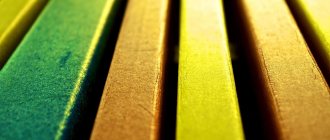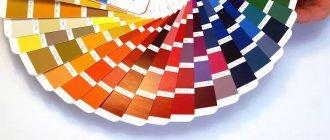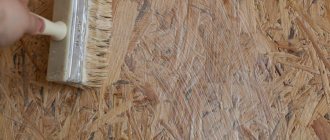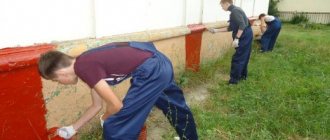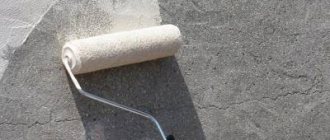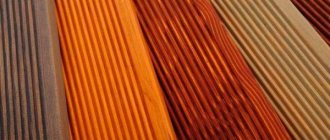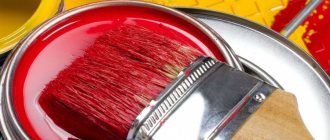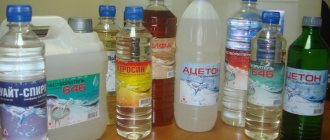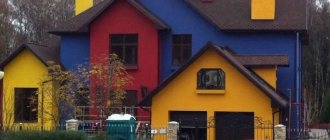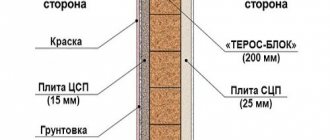Concrete is one of the most ancient building materials; the earliest examples date back to the sixth millennium BC. In those days, clay and lime were used as binders. Modern concrete with cement has been known since 1844, since then it has become the most used building material. It has a lot of advantages, but only one drawback - its unpresentable appearance. To improve design characteristics, various mineral additives are used during the production of concrete or its surface is painted. We won’t touch on additives, but rather talk about wear-resistant concrete paints for exterior use.
Wear-resistant concrete paint for exterior use
Types of concrete paints for exterior use
Depending on the base used and manufacturing technology, all paints for concrete are divided into several types.
| Paint type | Brief performance characteristics |
| Acrylic | They are made on the basis of polyacrylates and polymer derivatives, dry quickly, and are resistant to prolonged direct contact with water. Do not emit toxic substances into the air, universal use. The service life is up to ten years, the material is elastic - it is not afraid of thermal linear changes in the dimensions of concrete structures. They have high wear resistance. Disadvantage: negative reaction to low temperatures. |
| Water-epoxy | The combination of primers and dyes, for universal use, is characterized by increased moisture resistance. Two-component, have high adhesion to most building materials, including concrete. Disadvantage: prolonged exposure to sunlight may cause a slight change in color shades. |
Polymer | New materials have improved performance characteristics. They can be used in a wide temperature range and are resistant to chemical compounds, including aggressive ones. Disadvantages: high cost and long drying time. |
Vinyl | They have a rich color, most concrete surfaces can be coated in one layer - saving time and cost of painting work. Although practice shows that one layer is not enough. Paint can be applied using any available methods. |
Acrylic-silicone | They combine all the advantages of acrylic and silicone dyes and can be applied to concrete surfaces both indoors and outdoors. In terms of cost, they belong to the middle price segment. Due to the use of innovative additives, they are not afraid of harsh ultraviolet rays. |
Silicone paint for concrete
How to choose paint for concrete
Kinds.
To make a durable coating on a concrete base, manufacturers use several basic compounds.
- Epoxy paint is a two-component product that must be mixed before application. Most often, 2 layers are applied, drying time ranges from 12 to 24 hours. The service life of the epoxy coating is limited to 8 years, but the main disadvantage is the scarcity of colors.
- Acrylic paint for concrete is an aqueous suspension of polymers and resins. Acrylic successfully resists moisture and temperature changes, it dries quickly. The consumer is offered a wide range of colors. You can apply the material yourself; 1-2 layers are enough.
- Rubber (latex) paint is highly elastic. It forms a polymer film with a rich color on the concrete surface. The applied layer dries in just 20-30 minutes, and the operating temperature range is -50...+60°C.
- Polyurethane paints are great for budget repairs; they are suitable for painting both interior and exterior surfaces. The material has good covering power and is resistant to chemicals. The only drawback is the long curing time (3-4 weeks).
Purpose.
When choosing paint for concrete, you should pay attention to the purpose of the material.
- Almost all compositions are suitable for interior work. However, facade paints are more expensive, and products for exterior use may contain harmful organic solvents. Therefore, it is better to give preference to special paints for interior use.
- For external use, paints with a large operating temperature range, resistant to moisture and ultraviolet radiation, and also with dirt-repellent properties are required.
Key.
When choosing paint for concrete, it is important to consider the tone of the material.
- Glossy coatings look elegant, but the slightest stains and stains will be visible to the naked eye.
- Matte surfaces are more practical; they are suitable for decorating living spaces, dining rooms or kitchens.
- A compromise solution may be to purchase semi-matte paint, which combines beauty with practicality.
We have selected the 8 best concrete paints for review. All of them are widely represented on the Russian construction market. When distributing places in the rating, the opinion of the expert community and consumer reviews were taken into account.
How to paint concrete surfaces
No matter how expensive and high-quality the concrete paint for external surfaces is, if you do not adhere to the rules for performing painting work, it will not live up to expectations. And the manufacturer is not to blame in this situation. What recommendations should be followed to ensure reliable concrete painting?
Choosing a paint brand
A very important criterion; the final results depend on the correct choice. Before purchasing the material, carefully read the instructions. In doing so, pay attention to the following points:
- on what basis is the paint made?
- operating temperature conditions;
- attitude to ultraviolet radiation;
- chemical composition;
- does the material have plasticity;
- wear resistance.
Quick-drying paint for concrete "Unikom"
If you live in difficult climatic conditions, then the paint should be of the most expensive and high quality. Don't skimp on the cost, repainting concrete will cost significantly more than purchasing paint at a high price. Additionally, familiarize yourself with the technology for preparing the dye and the temperature conditions at which painting work can be performed.
Paints for concrete
Prices for various types of construction paints
Construction paints
Purpose of concrete structures
Elements of fencing, garden paths, parts of facade walls and landscape design are made from concrete. Concrete paths are used in the most difficult conditions; to paint them, you need to use only deep penetration dyes. For other structures, you can use paints that form only the top layer.
Practical advice. If you plan to make concrete paths in the garden, then issues with their painting should be resolved at the stage of preparing the solution. Various mineral dyes must be added to the mixture; this is the only way to guarantee long-term use of concrete without changing the original characteristics. To reduce the cost of construction, fill them in two layers. The first layer is made of ordinary concrete, and the second with dyes. The thickness of the second layer is within three to five centimeters. This is quite enough to achieve the required strength, and a three-centimeter layer of colored concrete does not wear off for many decades.
Freshly poured concrete paths, first layer without dye
Filled color layer, the design is made using a stencil
Painted concrete path
This method is considered optimal for one more reason - concrete paths constantly absorb moisture from the ground, and the presence of moisture has an extremely negative effect on adhesion performance. There are, of course, modern primers that allow you to more or less reliably waterproof paint from wet concrete, but in terms of their effectiveness they are much inferior to the above recommendation.
All other concrete structures are operated under more gentle conditions, the requirements for painting are less stringent, and any dyes can be used for external work.
Surface preparation
Concrete has a negative property - insufficient strength of the thin top layer. Even after running your hand over the surface, microscopic particles of material remain on it. This characteristic does not have a negative impact on durability, but can create problems during painting. To minimize negative effects, the concrete surface should be thoroughly prepared before painting.
- Level the concrete plane. It is necessary to seal not only cracks and depressions, but also to level out sharp protrusions. Each sharp protrusion is a place where loads are concentrated; no modern dyes can withstand them and will certainly be damaged. And then through the holes, water gets between the concrete and the paint and a continuous peeling process begins.
Scheme for repairing concrete walls with repair mixtures
Work on embedding reinforcement in concrete walls
- Clean the surface. If there are oily stains on it, that’s a big problem. Detergent will not help get rid of them, as some inexperienced craftsmen promise. Why? Firstly, the oil penetrates very deeply into the concrete, making it almost impossible to “get” it out of there. Secondly, effective detergents contain acids or surfactants. Both the first and second have an extremely negative impact on the strength of the material. In these places it becomes brittle and gradually crumbles under minor loads, and as a result, the paint will definitely fall off in the cleaned area. This means that it is impossible to clean the oil from the thickness of the concrete layer, and the remaining oil will constantly rise to the front surface due to the capillary effect. The consequences are just as negative - the paint in these places will certainly peel off. If an oily stain is found, it must be removed along with the concrete to a depth of 2–3 centimeters. Next, fill the hole with fresh mortar, wait a few days until it hardens completely, and only then continue painting.
Applying repair mortar
How to prepare the surface? First of all, let’s say that pure concrete is very rarely painted; the top leveling layer is subjected to such actions. And it is made from a cement-sand mixture. It needs to be prepared “fat”, the proportions of cement and sand are approximately 1:2. By increasing the amount of cement, the sand is held much more firmly. After the screed has hardened, it should be thoroughly rinsed with water under high pressure.
Cleaning the wall
Don't be afraid that high pressure may wash out the grooves; if this happens, you're in luck. This means that we managed to find a weak point and can take timely measures to eliminate it. Otherwise, it would still show itself, and it would be necessary not only to fill the recess, but also to renew the paint. But it will not be possible to make the patch invisible; it will be significantly different from the old paint for many reasons.
Primer
Applying primer to concrete
Be sure to use high-quality special primers.
On concrete surfaces, primers perform two tasks: they bind together the smallest particles of material and prevent moisture from getting between the concrete surface and the first layer of paint. Depending on the base, there are two types of primers:
- polyurethane. They perfectly protect the concrete surface from dust and prevent moisture from penetrating between the paint and the surface. They have high adhesion rates with most types of paints for external use;
- epoxy. More expensive option. Unlike polyurethane, they do not penetrate very deeply, but have better physical strength. In terms of price, they belong to the expensive segment.
Choose a primer based on its characteristics and the specific location where the paint will be used.
Facade primer
Primer concrete-contact
Acrylic deep penetration primer for interior and exterior use
Prices for deep penetration primer
Deep penetration primer
Technology of applying paint on concrete for exterior use
Do not violate the manufacturer’s recommended technology for preparing the material. As for consumption, it will be significantly more than what is written on the packaging, buy paint with a reserve.
Instructions for painting concrete walls
When applying paint, it must be rubbed very carefully into the surface. The best option is to use an air gun. Paint particles fly out of the nozzle at high speed, hit the surface hard and fill all micropores.
Compressor painting
An acceptable option is paint brushes. With their help, you can apply paint with force, which will also ensure reliable adhesion. Disadvantage: the work takes a lot of time and physical effort.
Another problem is painting concrete with brushes. While rubbing the material into the surface of the structure, grains of sand may flake off and will have to be removed. To do this, you need to wash the brush in a clean solvent, which takes time. And the percentage of solvent in the paint is constantly increasing, some liquid will always remain on the fibers, the new place needs to be covered with an additional layer, otherwise the difference in shades will be noticeable.
Applying paint with a brush
Painting with a brush
How to paint a facade
The worst option is to use rollers. The paint is not rubbed into the concrete, but only spread over the surface. Rollers, of course, are faster and easier to work with than brushes, but professional painters strongly advise against painting concrete surfaces with them, and not just those located outside the building.
Painting a concrete facade with rollers
The general purpose of all paint and varnish coatings is not only to give the treated surface a certain look and color, but also to isolate it from adverse external influences
The nuances of painting concrete surfaces
Prices for paint sprayers
Spray gun
